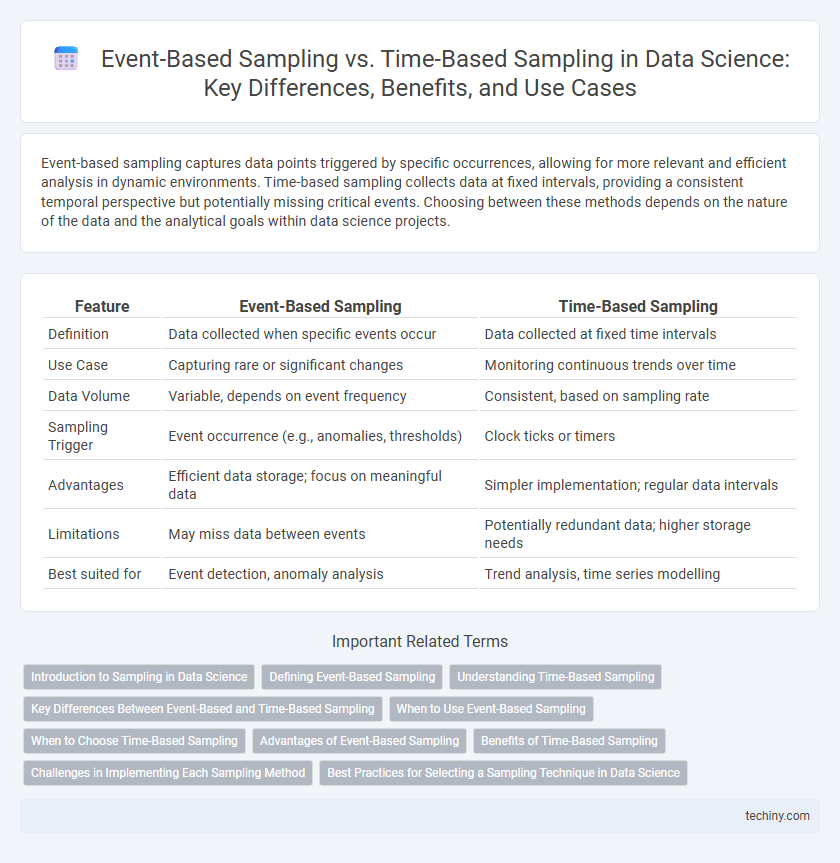Event-based sampling captures data points triggered by specific occurrences, allowing for more relevant and efficient analysis in dynamic environments. Time-based sampling collects data at fixed intervals, providing a consistent temporal perspective but potentially missing critical events. Choosing between these methods depends on the nature of the data and the analytical goals within data science projects.
Table of Comparison
| Feature | Event-Based Sampling | Time-Based Sampling |
|---|---|---|
| Definition | Data collected when specific events occur | Data collected at fixed time intervals |
| Use Case | Capturing rare or significant changes | Monitoring continuous trends over time |
| Data Volume | Variable, depends on event frequency | Consistent, based on sampling rate |
| Sampling Trigger | Event occurrence (e.g., anomalies, thresholds) | Clock ticks or timers |
| Advantages | Efficient data storage; focus on meaningful data | Simpler implementation; regular data intervals |
| Limitations | May miss data between events | Potentially redundant data; higher storage needs |
| Best suited for | Event detection, anomaly analysis | Trend analysis, time series modelling |
Introduction to Sampling in Data Science
Event-based sampling captures data points triggered by specific occurrences, enhancing responsiveness to significant changes in datasets. Time-based sampling collects data at fixed intervals, offering consistent temporal coverage and easier trend analysis over continuous periods. Choosing between event-based and time-based sampling depends on the nature of the data and the specific analytical objectives in data science projects.
Defining Event-Based Sampling
Event-based sampling captures data points triggered by specific occurrences or changes in the system, enabling dynamic and context-driven data collection. This method enhances the relevance and efficiency of data acquisition by focusing on meaningful events rather than fixed time intervals. Event-based sampling is particularly effective in environments with irregular or unpredictable data patterns, improving the accuracy and responsiveness of data analysis models.
Understanding Time-Based Sampling
Time-based sampling involves collecting data points at consistent, fixed intervals, ensuring uniform time gaps between observations. This method simplifies temporal data analysis by providing a regular sequence of timestamps, making trend detection and time series forecasting more straightforward. Often used in monitoring systems and sensor data collection, time-based sampling allows for predictable data volumes and consistent resolution across datasets.
Key Differences Between Event-Based and Time-Based Sampling
Event-based sampling captures data points only when predefined events occur, providing high relevance and reducing unnecessary data, while time-based sampling collects data at fixed intervals regardless of events, ensuring consistent temporal coverage. Event-based sampling is efficient for detecting anomalies or specific activities, but may miss background trends captured by time-based methods. Time-based sampling supports trend analysis and pattern recognition over time, whereas event-based focuses on event-triggered insights, making each suitable for different data science applications depending on the analysis goals.
When to Use Event-Based Sampling
Event-based sampling is ideal when capturing significant changes in data triggered by specific events or actions, ensuring efficient data analysis without redundant information. It is particularly useful in monitoring systems where real-time anomaly detection or event-driven insights are critical, such as user interactions or IoT sensor alerts. This method optimizes resource usage by recording only relevant data points, enhancing model accuracy in dynamic environments.
When to Choose Time-Based Sampling
Time-based sampling is ideal for monitoring continuous processes where data must be collected at regular intervals to identify trends or patterns over time. It ensures consistent data points for time series analysis and forecasting models, making it crucial in applications like sensor data monitoring, financial market analysis, and real-time system performance tracking. Choosing time-based sampling helps maintain uniformity and comparability across datasets, enabling more accurate temporal insights in data science projects.
Advantages of Event-Based Sampling
Event-based sampling captures data points precisely when significant changes or events occur, reducing unnecessary data collection and minimizing storage costs. This approach enhances real-time responsiveness and improves the accuracy of predictive models by focusing on relevant variations. It is particularly effective in applications with irregular or sparse events, ensuring efficient resource use and better anomaly detection.
Benefits of Time-Based Sampling
Time-based sampling ensures consistent data intervals, which simplifies time series analysis and forecasting models in data science. This approach enhances the ability to detect trends and seasonal patterns by providing uniform temporal granularity. Reliable synchronization with external time references improves data integration across multiple sources and systems.
Challenges in Implementing Each Sampling Method
Event-based sampling faces challenges in accurately detecting and capturing irregular or rare events, leading to potential data sparsity and bias in datasets. Time-based sampling requires careful selection of sampling intervals to balance data granularity and storage constraints, often struggling with missing critical transient phenomena. Both methods demand robust synchronization and preprocessing techniques to ensure data integrity and reliability for machine learning models.
Best Practices for Selecting a Sampling Technique in Data Science
Event-based sampling captures data points triggered by specific occurrences, ensuring relevance and reducing unnecessary data volume, while time-based sampling collects data at fixed intervals, offering consistency and ease of analysis. Best practices for selecting a sampling technique involve evaluating data granularity requirements, event significance, and resource constraints to balance accuracy and efficiency. Data scientists should leverage event-based sampling for dynamic, irregular phenomena and time-based sampling when temporal trends or regular monitoring are critical.
event-based sampling vs time-based sampling Infographic

 techiny.com
techiny.com